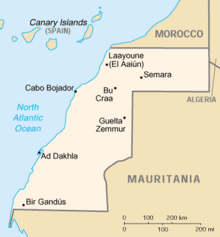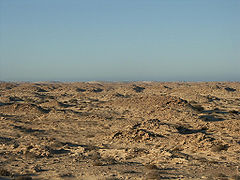- Río de Oro
-
- See also Río de Oro, Cesar and Río de Oro (Melilla)
Part of a series on the History of Western Sahara 
Background History of Morocco (Colonial wars)
Spanish Sahara · Spanish Morocco
Moroccan Army of Liberation
Harakat Tahrir · Sahrawi National Union Party
Madrid AccordsDisputed regions Saguia el-Hamra · Río de Oro
Southern Provinces · Free Zone ·Politics Legal status of Western Sahara · Politics of Morocco / of the SADR
Polisario Front (former members)
Royal Advisory Council for Saharan AffairsRebellions Pre-1975:
Ifni War · Zemla Intifada
post 1975:
Western Sahara War · Independence IntifadaConflict issues Refugee camps · Wall · Human rights in Western Sahara Sahara peace process Resolution 1495 · Resolution 1754 · Visiting mission · Referendum mission · ICJ Advisory Opinion · Settlement Plan · Houston Agreement · Baker Plan · Manhasset negotiations · Moroccan Initiative Río de Oro (Spanish for "Gold River", Arabic: وادي الذهب wādī-að-ðahab, often transliterated as Oued Edhahab), is, with Saguia el-Hamra, one of the two territories that formed the Spanish province of Spanish Sahara after 1969; it was originally taken as a Spanish colonial possession in the late 19th century. Its name seems to come from an east-west river which was supposed to have run through it formerly. The river was thought to have largely dried out - a wadi, as the name indicates - or have disappeared underground.
However, deriving from its previous name Rio do Ouro Portuguese seafarers applied it to the area, although no gold had been found there, neither in the water of the narrow gulf, probably mistaken for the river itself, nor in its neighbourhood.
Occupying the southern part of Western Sahara, the territory lies between 26° to the north and 21° 20' to the south. The area is roughly 71,042 mi.2 (184,000 km²), making it approximately two-thirds of the entire territory. The former provincial capital founded by the Spanish colonizers was Villa Cisneros, while the town's name under Moroccan administration has become ad-Dakhla .
The Battle of Río de Oro was a single-ship action fought in August of 1914 during the First World War. A British protected cruiser attacked a German auxiliary cruiser off the small Spanish colony of Río de Oro.
In 1975, as Spain retreated from the territory, Western Sahara was split between Mauritania and Morocco, even if this division was bitterly contested by the Polisario Front. The dividing line ran halfway through Río de Oro, with Morocco taking the northern part plus Saguia el-Hamra, and Mauritania annexing the lower third of the colony as a northern province called Tiris al-Gharbiyya (Western Tiris). Its provincial capital was already called Dakhla. After a disastrous four-year war with the Polisario, Mauritania relinquished Tiris al-Gharbiyya, withdrew from Western Sahara, and left Morocco and the Polisario as the sole protagonists in the conflict, which is not yet resolved; a cease-fire has been in effect since 1991.[1]
This area is today divided by the Moroccan military berm, with Morocco occupying the parts to the west of it, and the Polisario Front-held Free Zone, under the control of the Sahrawi Arab Democratic Republic to the east. These zones are temporary divisions negotiated as a part of the MINURSO ceasefire[2].
References
- ^ IBP USA (2006). Morocco Country Study Guide. Int'l Business Publications. pp. 26–27. ISBN 978-0-7397-1514-7. http://books.google.com/books?id=8GjrAeMS1dIC.
- ^ Military Agreement No. 1
Categories:- Geography of Western Sahara
- Former Spanish colonies
- States and territories established in 1969
- Spanish words and phrases
- Western Sahara stubs
- North Africa geography stubs
Wikimedia Foundation. 2010.


